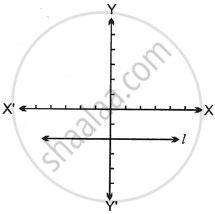Advertisements
Advertisements
Question
Show that points A(– 4, –7), B(–1, 2), C(8, 5) and D(5, – 4) are the vertices of a parallelogram ABCD
Solution
We know that, slope of line = `(y_2 - y_1)/(x_2 - x_1)`
Slope of side AB = `(2 - (-7))/(-1 - (-4))`
= `(2 + 7)/(-1 + 4)`
= `9/3`
= 3 ......(i)
Slope of side BC = `(5 - 2)/(8 - (-1))`
= `3/(8 + 1)`
= `3/9`
= `1/3` ......(ii)
Slope of side CD = `(-4 - 5)/(5 - 8)`
= `(-9)/(-3)`
= 3 .....(iii)
Slope of side AD = `(-4 - (-7))/(5 - (-4))`
= `(-4 + 7)/(5 + 4)`
=`3/9`
= `1/3` ......(iv)
∴ Slope of side AB = Slope of side CD ......[From (i) and (iii)]
∴ Side AB || side CD
∴ Slope of side BC = Slope of side AD .......[From (ii) and (iv)]
∴ Side BC || side AD
Both the pairs of opposite sides of ABCD are parallel
∴ ▢ABCD is a parallelogram.
∴ Points A(– 4, – 7), B(– 1, 2), C(8, 5) and D(5, – 4) are the vertices of a parallelogram.
RELATED QUESTIONS
Find the slope of the line passing through the points A(2, 3) and B(4, 7).
Find the slope of the line parallel to AB if : A = (−2, 4) and B = (0, 6)
Without using the distance formula, show that the points A(4, 5), B(1, 2), C(4, 3) and D(7, 6) are the vertices of a parallelogram.
Find x, if the slope of the line joining (x, 2) and (8, −11) is `−3/4`.
Find the value(s) of k so that PQ will be parallel to RS. Given : P(2, 4), Q(3, 6), R(8, 1) and S(10, k)
Angles made by the line with the positive direction of X–axis is given. Find the slope of these line.
90°
If A(1, –1), B(0, 4), C(–5, 3) are vertices of a triangle then find the slope of each side.
Fill in the blank using correct alternative.
Seg AB is parallel to Y-axis and coordinates of point A are (1,3) then co–ordinates of point B can be ........ .
Determine whether the given point is collinear.
L(1,2), M(5,3) , N(8,6)
Find the type of the quadrilateral if points A(–4, –2), B(–3, –7) C(3, –2) and D(2, 3) are joined serially.
Find the slope of the diagonals of a quadrilateral with vertices A(1, 7), B(6, 3), C(0, –3) and D(–3, 3).
Find the slope of a line, correct of two decimals, whose inclination is 60°
Find the slope of a line passing through the given pair of points (9,-2) and (-5,5)
Find the slope of a line parallel to the given line 4x-2y = 3
Find the slope and the y-intercept of the following line 2x + 3y = 12
Verify whether the following points are collinear or not:
A(1, –3), B(2, –5), C(–4, 7).
If the lines 7y = ax + 4 and 2y = 3 − x, are parallel to each other, then the value of ‘a’ is:
In the figure, line l is parallel to X-axis. Which of the following statement is true?

Find the slope of the line passing through given points G(3, 7) and K(–2, –3).
